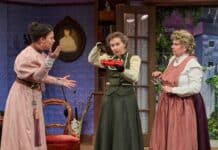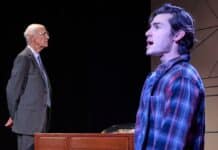A small, nondenominational chapel situated in a cemetery inspired playwright Bob Bartlett to stage a new play in it featuring Mary Shelley, who, at the age of 18 in 1816, wrote the novel that became the science fiction phenomenon Frankenstein. Bartlett started simply with a title, Mary Shelley’s Monsters. He envisioned, as he has written, a “horror play” that “would in some way bring Shelley face-to-face with her creations.”
The enigmatic execution of that promising premise can now be experienced firsthand in the Chapel of the historic Congressional Cemetery in an immersive performance that stretches the imagination the way that a great classical poem does: it is rich in poetic diction and arch syntax, rife with evocative imagery, and abounding in aphorisms and epigrams that cumulatively invite audiences to connect their own experiences and emotions and infer their own meaning.
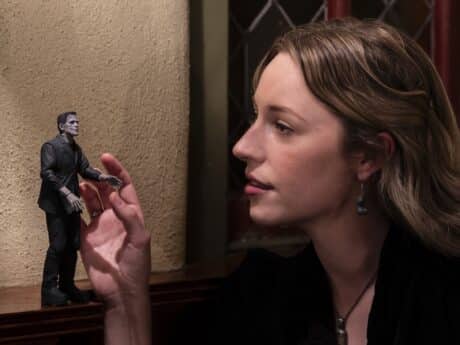
The story — which is not so much a plot as a cavalcade of poetic language — is given voice by two intensely visceral actors playing characters first authored by Mary Shelley: JC Payne as the scientist Victor Frankenstein and Jon Beal as the Creature. Their up-close physicality and vocal force are remarkable. Mary Shelley herself appears portrayed with inscrutable composure by Katrina Clark. Inside the chapel, with its eerie acoustics (episodically erupting in sound designer Kenny Neal’s thunderclaps), director Alex Levy has crafted a hauntingly theatrical production using only the existing chapel’s entrance, nave, and chancel along with the slightest of lighting effects: candelabras and sconces.
I attended a matinee when warm, yellowed daylight streamed in through stained-glass windows. I imagine everything’s creepier and chillier at night.
Details from Shelley’s life are referenced throughout in a kind of code. Her mother, the famous protofeminist Mary Wollstonecraft, died of an accidental infection ten days after giving birth to her — thus in Bartlett’s script Mary Shelley calls herself “a daughter who murdered a mother.” The line takes on ironic resonance as it is delivered under the chancel arch, which bears the inscription “I am the Resurrection and the Life.” Similarly alluded to in the script — and echoed in sounds of youngsters — are the three of Shelley’s four children who died in infancy or early childhood. In a profound sense, mortality and motherhood are intertwined in Mary Shelley’s Monsters in death’s embrace.
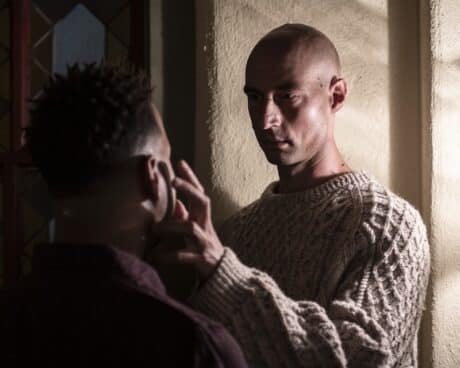
This, to my mind, is the biographical context of the drama that Mary Shelley devised in Frankenstein and that Bartlett has borrowed from fascinatingly in his magnificently meditative treatment of it. With the two male characters, Victor and his cobbled-together creation, the play returns again and again to the contrast and tension between Victor’s masculinist creation of “life” as if an omnipotent father-god — which leaves the “son” his Creature in lifelong rage and woundedness (“Why have you created, yet forsaken me?”) — and a young woman’s grief at the death of her babies and the mother who bore her.
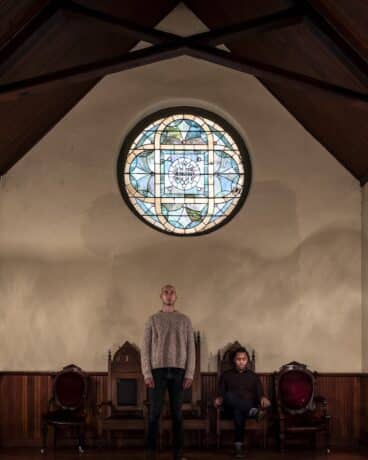
About two-thirds of the way through Mary Shelley’s Monsters, the performance switches gears from what had been somewhat stentorian recitation to a broadly comic play within the play: a sketch comedy that the three players call “Three Days in Geneva.” This passage is loosely based on Mary Shelley’s “staycation” with her randy paramour (and later husband), the poet Percy Bysshe Shelley, and her stepsister, who together visit Lord Byron and his physician — the three actors anticly playing the five roles. To amuse themselves, they compete to see who can tell the best ghost story, and the teenage Mary Shelley (here called “history’s very first goth girl!”) comes up with a “better scary story than the boys.” Thus was born her existential inquiry into the disastrous consequences of a man who tries to make a man.
At one point, Mary cherishes and sings sorrowfully to a puppet child as if her creation, and at another, she regards an action figure movie monster as if with regret. Her character has a backstory that is real; the play’s two other characters’ origins are solely fictional. With a playwright’s egalitarian allyship to his characters and in an ebullience of eloquence, Bartlett has imagined all three in ways that taunt our understanding and tantalize our interpretation.
Running Time: 85 minutes with no intermission.
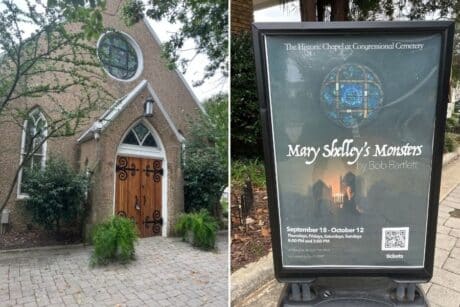
Mary Shelley’s Monsters plays through October 12, 2025 (Thursdays, Fridays, and Saturdays at 8:00 PM and Saturdays and Sundays at 2:00 PM), at Congressional Cemetery, 1801 E St SE, Washington, DC. Tickets are $35 and can be purchased online. Some content may not be appropriate for children.
This performance will happen in the Chapel at Congressional Cemetery, which is a brief walk from the main gate. Attendees will receive an email the day before their scheduled performance with reminders and updates — and will be asked to gather outside the chapel doors. Attendees do not need to bring a printed ticket to the gate: names of attendees will be on a registration list.
Because of the uniqueness of the venue/performance space, the production seats only 50 guests per performance. Seating (unpadded) is provided in the chapel.
The program for Mary Shelley’s Monsters is online here.
Mary Shelley’s Monsters
By Bob Bartlett
CREATIVE TEAM
Directed by Alex Levy
Sound design by Kenny Neal
Costumes, props, puppet by Bob Bartlett
Mask design and construction by Jon Beal
CAST
Jon Beal as the Creature
Katrina Clark as Mary Shelley
JC Payne as Victor Frankenstein
SEE ALSO:
Playwright Bob Bartlett on adapting ‘Frankenstein’ in Italy (feature by Bob Bartlett, September 11, 2025)

